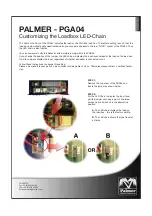
Sauter GmbH
Ziegelei 1
D-72336 Balingen
E-Mail: info@sauter.eu
Tel: +49-[0]7433- 9933-199
Fax: +49-[0]7433-9933-149
Internet: www.kern-sohn.com
Instruction Manual
HN-D
HN-D-BA-e-1213
1
MOBILE LEEB HARDNESS TESTER
Table of contents
Cautions
1. Summary
1.1 Measuring Principle Scope
1.2 Hardness Value „L“
1.3 Features
1.4 Applications
1.5 Primary Industries
2. Technical Specifications
3. Instrument’s views
4. Checking Supplied Accessories
5. Operation Instruction
5.1 Keys and their Functions
5.2 LCD Screeen
5.3 Settings
5.3.1 Material Type
5.3.2 Hardness Scale
5.3.3 Data in One Group
5.3.4 How to browse Data
5.3.5 Setting Date and Time
5.3.6 Calibration
5.4 The Format of Memory Data
5.5 Backlight
5.6 Automatic Shut-Off
5.7 Charging
6. Data Printing
7. Hardness Testing
7.1 Checking of Settings
7.2 Sample Preparation
8. Troubles and solutions
9. Maintenance and Service
9.1 Impact Device Maintenance
9.2 How to Store the Reports
9.3 Normal Maintenance Procedures
Appendix 1 Daily Checking
Appendix 2 Factors affecting the Accuracy
Appendix 3 Measuring Range
Applicable Standards
10. Declaration of Conformity
Cautions
Please carefully read this first
1. Any components of the instrument may not be
submerged into water or exposed to rain, which could
cause a battery explosion ort he display might be
damaged.
2. If the instrument isn’t used for a longer period, it should
be stored in dry environment and in its original transport
case. The environmental temperature should be within the
range of -30°C up to +80°C and relative humidity from
(RH) 5% bis 95%.
1. Summary
1.1 Measuring Principle Scope
When the test is carried out, an impact body with a
tungsten carbide test tip is being impelled by spring force
against the surface to be tested, from which it rebounds.
Impact and rebound velocities are measured by the
following method: a permanent magnet integrated in the
impact body passes through a coil and induces an electric
voltage during its travel back and forth. These voltages are
proportional to the velocities and are processed and
displayed as the hardness value “L” at the instrument.
Modern electronics with power saving features provide a
long operating life.
Illustration
The big-sized LCD display always shows how the HN-D is
configured to test.
Variable function keys allow quick changes of common test
parameters. No subjective measuring errors are possible,
giving highly repeatable results. Internal self diagnostics
with error messages assure reliable test results.
Readings can be stored automatically in the internal
memory or being directly sent to a printer. PC evaluation
software enables a data analysis. These conversions to
other scales (HRC, HRB, HB, HV, HSD etc.) are
programmed into the electronics and can be shown directly
on the display as test result.
1.2 Hardness Value „L“
This term, 1978 introduced by Dr. Dietmar Leeb into
measuring technology, is the quotient fort he impact body’s
rebound and impact velocity, multiplied by 1000. Harder
materials produce higher rebound velocities than less
harder ones. With reference to a particular material group

























